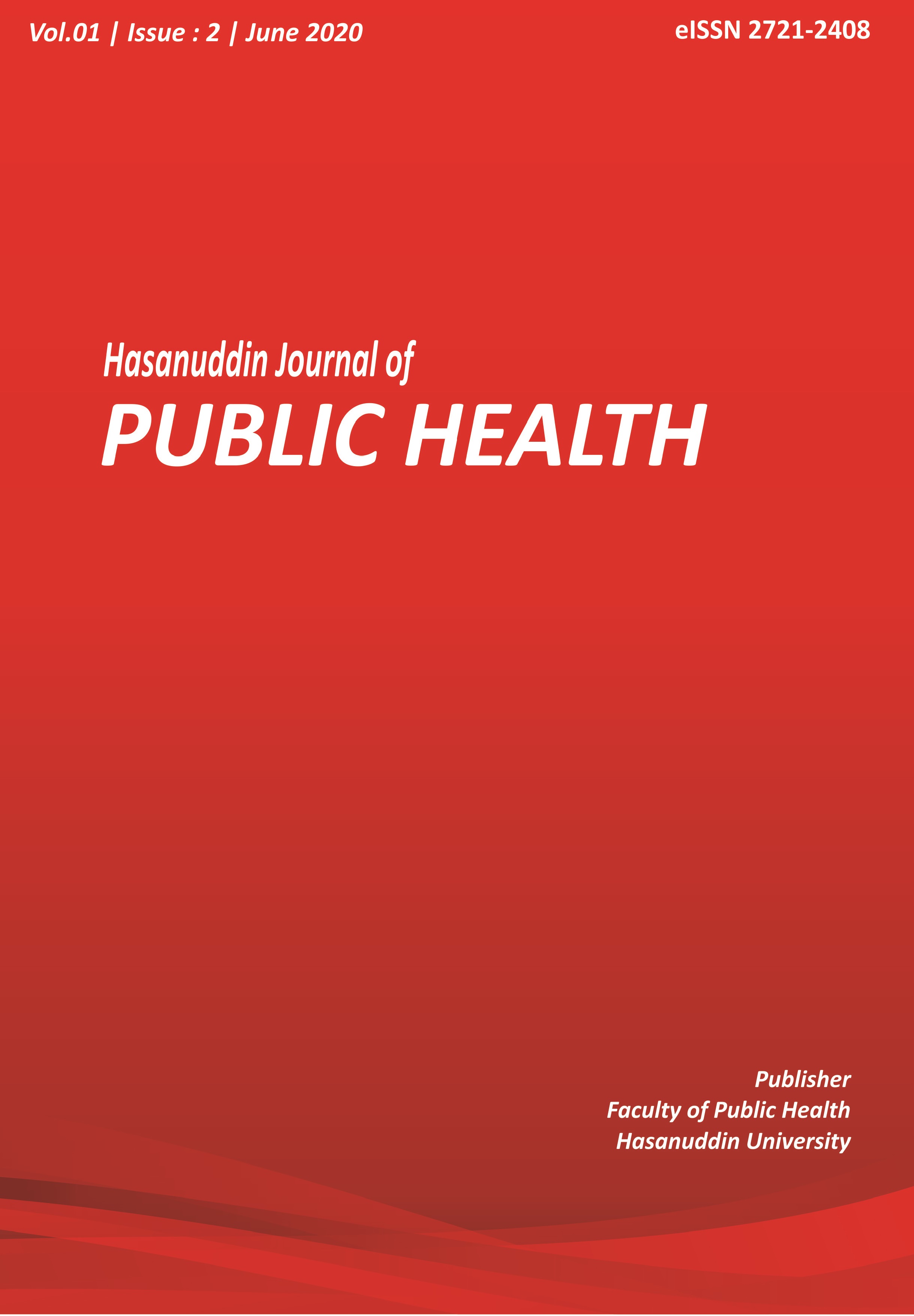Main Article Content
Abstract
Some coastal communities still have the habit of defecating in open areas such as on the beach or in the garden. That is because the public does not yet know about the poor behavior related to sanitation that will affect the quality of other public health. The purpose of this study is to apply the Antecedent Behavior Consequences chain method for modification of Open Defecation behavior in child targets. This research is a quantitative study using quasy experiment design with time series design. The population is all class IV-VI at SDN Tamalate who still defecate carelessly. A sample of 37 students. The sampling technique in this study was exhaustive sampling. Data analysis using t-dependent test, Mc. Nemar and chi square with a significant level of 0.05. The results of this study indicate that there is a difference in intention score with the statistical test results of 98.18%, with a knowledge score of 10.8% to 100%, the action score from never defecated by 0.0% to 86.5% with a value p=0,000. While those who have utilized the facilities amounted to 97.3%. Suggestions for the government, should collaborate with schools and health centers to replicate or implement learning while playing with the method of snakes and ladders in providing education, about stopping open defecation in children.
Keywords
Article Details
Copyright (c) 2020 by author

This work is licensed under a Creative Commons Attribution-ShareAlike 4.0 International License.
- Every manuscript submitted to must observe the policy and terms set by the Hasanuddin Journal of Public Health (HJPH).
- Publication rights to manuscript content published by the Journal of Public Health is owned by the journal with the consent and approval of the author(s) concerned. (download copyright agreement)
- Complete texts of electronically published manuscripts can be accessed free of charge if used for educational and research purposes according to copyright regulations.

Hasanuddin Journal of Public Health Universitas Hasanuddin is licensed under a Creative Commons Attribution-ShareAlike 4.0 International License.
References
- Syaifuddin. Sikap Manusia. Bandung: Pustaka Belajar; 2010.
- Kemenkes RI. Profil Kesehatan Indonesia Tahun 2011. Jakarta: Kementerian Kesehatan RI; 2011.
- WHO. Progress on Sanitation and Drinking-Water. Geneva: World Health Organization; 2011.
- Soekadji, Soetarlinah. Modifikasi Perilaku: Penerapan Sehari-hari dan Penerapan Profesional. Yogyakarta: Liberty; 1983.
- Dinkes Takalar. Profil Dinas Kesehatan Kabupaten Takalar 2018. Takalar: Dinas Kesehatan Kabupaten Takalar; 2019.
- Notoatmodjo, S. Kesehatan Masyarakat Ilmu dan Seni. Jakarta: Rineka Cipta; 2007.
- Sugiyono. Metode Penelitian Kuantitatif Kualitatif dan R&D. Bandung: Alfabeta; 2007.
- Triwahyudi D. Media Terhadap Peningkatan Niat Bertindak dan Persepsi Kesehatan Gigi. Jurnal Edu Health. 2015;5(2):154-157.
- Mada, Yudhi Prasetya. Analisis Pengaruh Sikap terhadap Perilaku, Norma Subyektif dan Kontrol Kepemilikan yang Dirasakan terhadap Niat dan Perilaku Konsumen. Infestasi, 2005;1(1):79-88.
- Depkes RI. Profil Kesehatan Indonesia Tahun 2003. Jakarta: Departemen Kesehatan RI; 2004.
- Siyam SNL, Nurhapsari A, Benyamin B. Pengaruh Stimulasi Permainan Ular Tangga Tentang Gingivitis Terhadap Pengetahuan Anak Usia 8-11 Tahun Studi Terhadap Siswa SD Negeri Kuningan 04 Kecamatan Semarang Utara. ODONTO Dental Journal. 2015;2(1):25-28.
- Handayani, Irma. Pengaruh Penyuluhan dengan Media Permainan Ular Tangga terhadap Pengetahuan tentang Buah dan Sayur pada Siswa MTS Almanar Kecamatan Hamparan Perak. Jumantik. 2017-2018;3(1):115-123.
- Saputri, Lila O., Kristiawati, Ilya K. Peningkatan Pengetahuan dan Sikap dalam Pemilihan Jajanan Sehat Menggunakan Alat Permainan Edukatif Ular Tangga. [Skripsi]. Surabaya: Universitas Airlangga; 2012.
- Notoatmodjo, S. Kesehatan Masyarakat Ilmu dan Seni. Jakarta: Rineka Cipta; 2007.
- Hamdalah A. Efektivitas Media Cerita bergambar dan Ular Tangga dalam Pendidikan Kesehatan Gigi Dan Mulut Siswa SDN 2 Patrangkabupaten Jamber. Jurnal Promkes. 2013;1(2):118-123.
- Salim Majid. Jamban Keluarga. Jakarta: PT. Gramedia Pustaka Utama; 2009.
- Winarti, Nurmalasari S. Hubungan Perilaku Buang Air Besar (BAB) dengan Kejadian Diare di Desa Krajan Kecamatan Jatinom Kabupaten Klaten. Jurnal Kebidanan. 2016;7(12):14-25.
References
Syaifuddin. Sikap Manusia. Bandung: Pustaka Belajar; 2010.
Kemenkes RI. Profil Kesehatan Indonesia Tahun 2011. Jakarta: Kementerian Kesehatan RI; 2011.
WHO. Progress on Sanitation and Drinking-Water. Geneva: World Health Organization; 2011.
Soekadji, Soetarlinah. Modifikasi Perilaku: Penerapan Sehari-hari dan Penerapan Profesional. Yogyakarta: Liberty; 1983.
Dinkes Takalar. Profil Dinas Kesehatan Kabupaten Takalar 2018. Takalar: Dinas Kesehatan Kabupaten Takalar; 2019.
Notoatmodjo, S. Kesehatan Masyarakat Ilmu dan Seni. Jakarta: Rineka Cipta; 2007.
Sugiyono. Metode Penelitian Kuantitatif Kualitatif dan R&D. Bandung: Alfabeta; 2007.
Triwahyudi D. Media Terhadap Peningkatan Niat Bertindak dan Persepsi Kesehatan Gigi. Jurnal Edu Health. 2015;5(2):154-157.
Mada, Yudhi Prasetya. Analisis Pengaruh Sikap terhadap Perilaku, Norma Subyektif dan Kontrol Kepemilikan yang Dirasakan terhadap Niat dan Perilaku Konsumen. Infestasi, 2005;1(1):79-88.
Depkes RI. Profil Kesehatan Indonesia Tahun 2003. Jakarta: Departemen Kesehatan RI; 2004.
Siyam SNL, Nurhapsari A, Benyamin B. Pengaruh Stimulasi Permainan Ular Tangga Tentang Gingivitis Terhadap Pengetahuan Anak Usia 8-11 Tahun Studi Terhadap Siswa SD Negeri Kuningan 04 Kecamatan Semarang Utara. ODONTO Dental Journal. 2015;2(1):25-28.
Handayani, Irma. Pengaruh Penyuluhan dengan Media Permainan Ular Tangga terhadap Pengetahuan tentang Buah dan Sayur pada Siswa MTS Almanar Kecamatan Hamparan Perak. Jumantik. 2017-2018;3(1):115-123.
Saputri, Lila O., Kristiawati, Ilya K. Peningkatan Pengetahuan dan Sikap dalam Pemilihan Jajanan Sehat Menggunakan Alat Permainan Edukatif Ular Tangga. [Skripsi]. Surabaya: Universitas Airlangga; 2012.
Notoatmodjo, S. Kesehatan Masyarakat Ilmu dan Seni. Jakarta: Rineka Cipta; 2007.
Hamdalah A. Efektivitas Media Cerita bergambar dan Ular Tangga dalam Pendidikan Kesehatan Gigi Dan Mulut Siswa SDN 2 Patrangkabupaten Jamber. Jurnal Promkes. 2013;1(2):118-123.
Salim Majid. Jamban Keluarga. Jakarta: PT. Gramedia Pustaka Utama; 2009.
Winarti, Nurmalasari S. Hubungan Perilaku Buang Air Besar (BAB) dengan Kejadian Diare di Desa Krajan Kecamatan Jatinom Kabupaten Klaten. Jurnal Kebidanan. 2016;7(12):14-25.
